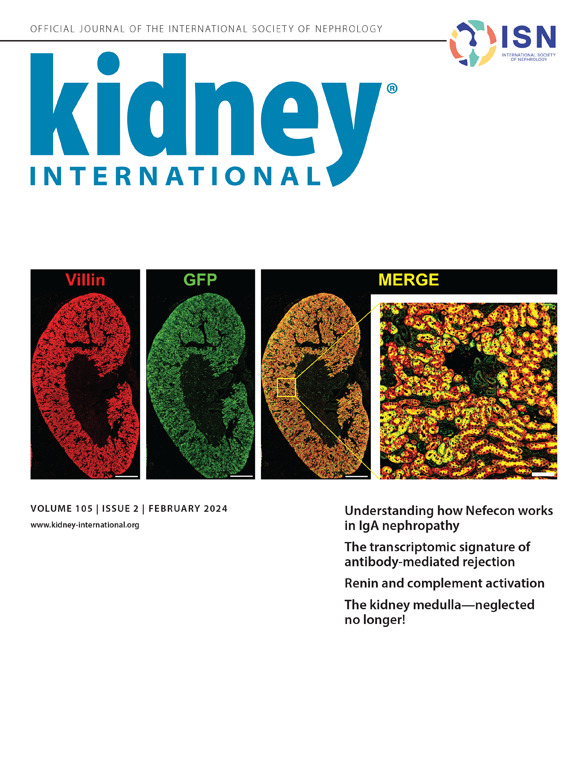阿莫西林结晶尿和阿莫西林诱发的晶体肾病:叙述性综述。
IF 14.8
1区 医学
Q1 UROLOGY & NEPHROLOGY
引用次数: 0
摘要
阿莫西林结晶尿(AC)是指阿莫西林在尿液中沉淀为三水阿莫西林晶体。阿莫西林诱发晶体肾病(AICN)是指三水合阿莫西林晶体阻塞肾小管,导致急性肾损伤(AKI)。AC 和 AICN 通常被认为罕见且不严重,但在接受大剂量静脉注射阿莫西林(HDIVA ≥150 毫克/千克/天)的患者中,AC 和 AICN 的发生率会比以往报道的更高。AC 患病率从 24% 到 41% 不等。AICN 患病率仍不清楚。AC 一般无症状,但突然出现的大镜下血尿和尿液混浊可提示诊断。通过检测尿液中的三水阿莫西林结晶可确诊 AC。AC 是 AKI 的危险因素。由于缺乏无创诊断工具,诊断 AICN 更具挑战性。接受 HDIVA 治疗的患者如果出现 AKI 和 AC,在排除其他 AKI 病因(主要是败血症和急性间质性肾炎)后,就会被怀疑为 AICN。在无法进行 AC 检测的情况下,如果存在已证实(血液中阿莫西林含量高、尿液 pH 值低)或疑似(快速静脉注射阿莫西林、低血容量)的 AC 危险因素,则可提示其诊断。AICN 的治疗包括停用/减少阿莫西林剂量和容量复苏,以改善肾小管流量和尿量,降低阿莫西林的过饱和度。停用阿莫西林后,患者的肾功能一般会迅速恢复正常,但有 10%-40% 的患者需要进行肾脏替代治疗。目前还没有死亡直接归因于 AICN。今后还需要进行研究,以评估 AC/AICN 的确切发病率,并确定最佳治疗方案。本文章由计算机程序翻译,如有差异,请以英文原文为准。
Amoxicillin crystalluria and amoxicillin-induced crystal nephropathy: a narrative review
Amoxicillin crystalluria (AC) refers to the precipitation of amoxicillin in the urine as amoxicillin trihydrate crystals. Amoxicillin-induced crystal nephropathy (AICN) refers to the obstruction of kidney tubules by amoxicillin trihydrate crystals, resulting in acute kidney injury. Usually considered rare and not serious, AC and AICN would be more frequent in patients receiving high-dose i.v. amoxicillin (≥150 mg/kg per day) than previously reported. AC prevalence ranges from 24% to 41%. AICN prevalence remains unclear. AC is generally asymptomatic, but sudden macroscopic hematuria with cloudy urine suggests the diagnosis. AC is diagnosed by detecting amoxicillin trihydrate crystals in urine. AC is a risk factor for acute kidney injury. Diagnosing AICN is more challenging in the absence of noninvasive diagnostic tools. It is suspected in high-dose i.v. amoxicillin–treated patients who develop acute kidney injury and AC, and after excluding other causes of acute kidney injury (mainly sepsis and acute interstitial nephritis). When testing for AC is unavailable, the presence of demonstrated (high blood amoxicillin levels and low urinary pH) or suspected (rapid i.v. amoxicillin administration and hypovolemia) risk factors for AC suggests its diagnosis. AICN management includes discontinuation/reduction of amoxicillin doses and volume resuscitation to improve tubular flow and urine output and decrease amoxicillin supersaturation. Patients generally recover normal kidney function rapidly after stopping amoxicillin, but renal replacement therapy is required in 10%-40% of patients. No deaths have been directly attributed to AICN. Future studies are needed to assess the exact prevalence of AC/AICN and to define optimal therapeutic options.
求助全文
通过发布文献求助,成功后即可免费获取论文全文。
去求助
来源期刊

Kidney international
医学-泌尿学与肾脏学
CiteScore
23.30
自引率
3.10%
发文量
490
审稿时长
3-6 weeks
期刊介绍:
Kidney International (KI), the official journal of the International Society of Nephrology, is led by Dr. Pierre Ronco (Paris, France) and stands as one of nephrology's most cited and esteemed publications worldwide.
KI provides exceptional benefits for both readers and authors, featuring highly cited original articles, focused reviews, cutting-edge imaging techniques, and lively discussions on controversial topics.
The journal is dedicated to kidney research, serving researchers, clinical investigators, and practicing nephrologists.
 求助内容:
求助内容: 应助结果提醒方式:
应助结果提醒方式:


